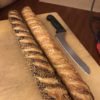If there’s one thing the general public knows about the modern Bay Area, it’s that it has rapidly – perhaps even alarmingly – gentrified over the last decade. What’s less known is what toast has to do with it.
Brendan visited SF eatery The Mill with food writer John Birdsall and sampled some famously costly carbs — the symbol of a backlash against the techie-fication of a city.

Brendan Francis Newnam: When did the San Francisco toast trend begin?
John Birdsall: Really about a year ago, when this place, The Mill, opened. And The Mill has two businesses inside. One is Four Barrel Coffee. The other one is Josey Baker Bread.
Josey Baker is a great guy who just really loved bread, and he started a bread CSA a few years ago. He was bartending at the time and he would make bread at home, really studied bread-making, and then you could pick up your loaves at the bar. And eventually, he saved up enough money that he got a baking space. So now he shares space with Four Barrel Coffee.
Brendan Francis Newnam: So it sounds like Josey really cares about his bread, he’s a craftsman. And I’m looking at this toast and it is beautiful. It’s thick, there’s variations; you’re having a raisin bread, I’m having a dark rye. It’s hearty bread.
Still, people writing about the toast haven’t focused exclusively on the quality of the bread. The price tag raised a few eyebrows.
John Birdsall: Right. So the way that $4 toast became this kind of meme in San Francisco was that a few tech writers jumped on it. Last summer, this story in Venture Beat was titled “$4 Toast: Why The Tech Industry Is Ruining San Francisco.”
The thing to know about San Francisco right now is that it’s really awash in tech money. And $4 toast became a symbol of this new tech class, really. You know, everyone thinks of them as these 25-year-old engineers who are making tons of money buying up prime real estate in places where other San Franciscans are priced out.
Brendan Francis Newnam: So it’s like a gentrification debate.
John Birdsall: Right, exactly. And $4 toast became the convenient symbol of everything that’s wrong about the new tech economy.
Brendan Francis Newnam: Because that’s a lot of money for a slice of toast. It sounds like a lot of money for a slice of toast, right?
John Birdsall: $4 dollars for a thick slice of toast that took intention and time and patience. And this whole other network of farmers who are raising grains in a certain way and, you know, a miller who is milling it in a certain way. I feel like I’m buying that whole system, and I’m helping to keep that system alive.
You know, a lot of people in San Francisco and the tech industry, they’re creative people, kind of making stuff that exists in the cloud somewhere. It’s not tangible. And the thing about Josey Baker’s bread is that it’s tangible, it takes time and patience and it takes knowledge. And so there’s kind of a fascination by this tech creative class for things like that.
Brendan Francis Newnam: I don’t really know where I come down on this. I’m a little torn. On the one hand, I’m like, yeah, this is quality stuff. We pay money for a latte, and the beans and coffee really don’t cost that much money — that’s a huge mark-up.
But something about toast… it just seems silly that just heated-up bread would be over maybe even $2 dollars.
John Birdsall: Well, two things. One, you know, San Francisco has this amazing and very old bread culture…
Brendan Francis Newnam: Sourdough, you’re talking about?
John Birdsall: …Yeah, exactly. Our sourdough tradition goes back to the 19th century. Even in the 20th century, you know, over in Berkeley, Steve Sullivan of Acme Bread started making levains, spontaneously-fermented sourdough along French lines. Bread is one of those great foods of San Francisco. So to pay a premium for bread here doesn’t seem outrageous to a lot of people.
Brendan Francis Newnam: It’s in San Francisco’s DNA, so people are comfortable buying high quality product and spending a little bit more money for it.
John Birdsall: Right. The other thing is that in the West, we sort of look to American traditions and European traditions — like English traditions — and think of toast as something that’s very insignificant. In fact, if you look East rather than West, you know, if you look to Asia — especially Japan — you see this very old cafe culture that’s devoted to toast. There are these very old cafes in Tokyo — like Paulista Cafe, which is over 100 years old — and their specialty is these “toast sets.” It tends to be middle-aged businessmen who go there; they’ll buy coffee and they’ll buy a single, thick slice of toast that’s been buttered and sliced.
Brendan Francis Newnam: All right, let’s take a bite into the toast here. You got the raisin toast?
John Birdsall: It’s a raisin-fennel bread and it’s smeared with honey.
Brendan Francis Newnam: And I have dark rye smeared with pumpkin butter and sea salt. It looks gorgeous. It’s heavy in my hand, actually. It feels almost like a little dumbbell for runners.
Really hearty, hearty bread, I’ll give you that.
John Birdsall: It’s absolutely delicious. It’s dense and satisfying. It’s chewy and sort of elastic. There’s a really dark crust on the top, so it’s kind of crisp. This is not something that you’re just gonna eat in two minutes and head for the door. I mean, this is something that you really have to spend some time with.
Brendan Francis Newnam: Well, so, you’ve been covering food for a while. You’ve lived here all of your life. What is gonna be the next toast that we’re gonna read about? A similar kind of thing that’s becoming… some would say “fetishized,” others would say finally being treated with it’s proper respect.
John Birdsall: I was talking with a chef friend of mine the other day, and she said that her sort of leading-edge trend was gonna to be to open up a restaurant where they only used crock-pots and microwaves. Sort of like redeeming that food that ‘s horrible. So maybe something like that.
Brendan Francis Newnam: Microwave bread, $5?
John Birdsall: Yeah, $5! Absolutely.


